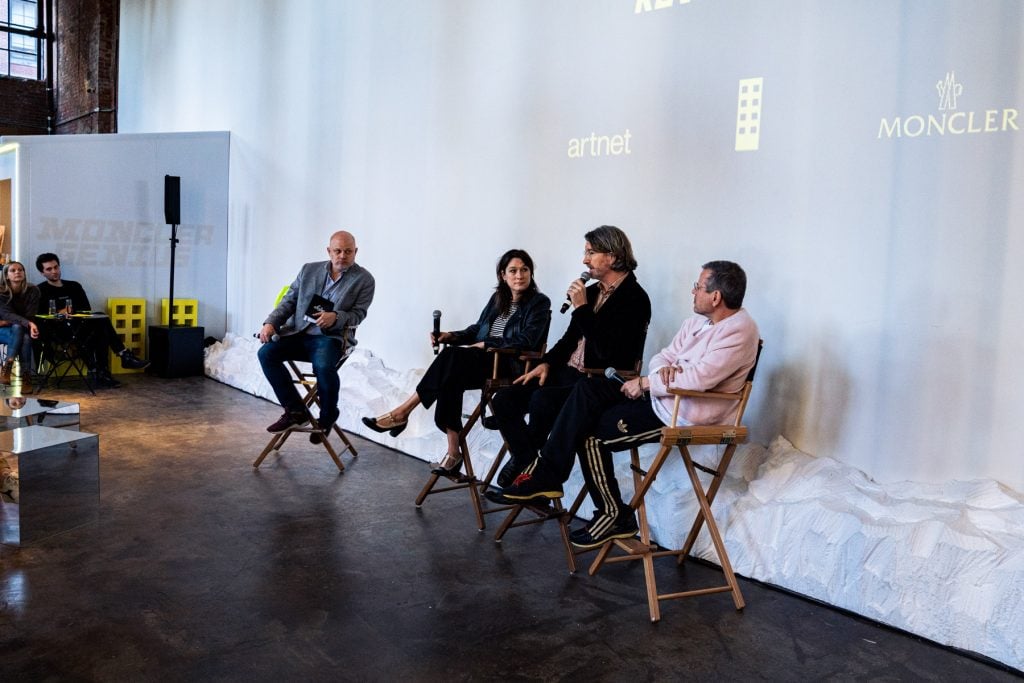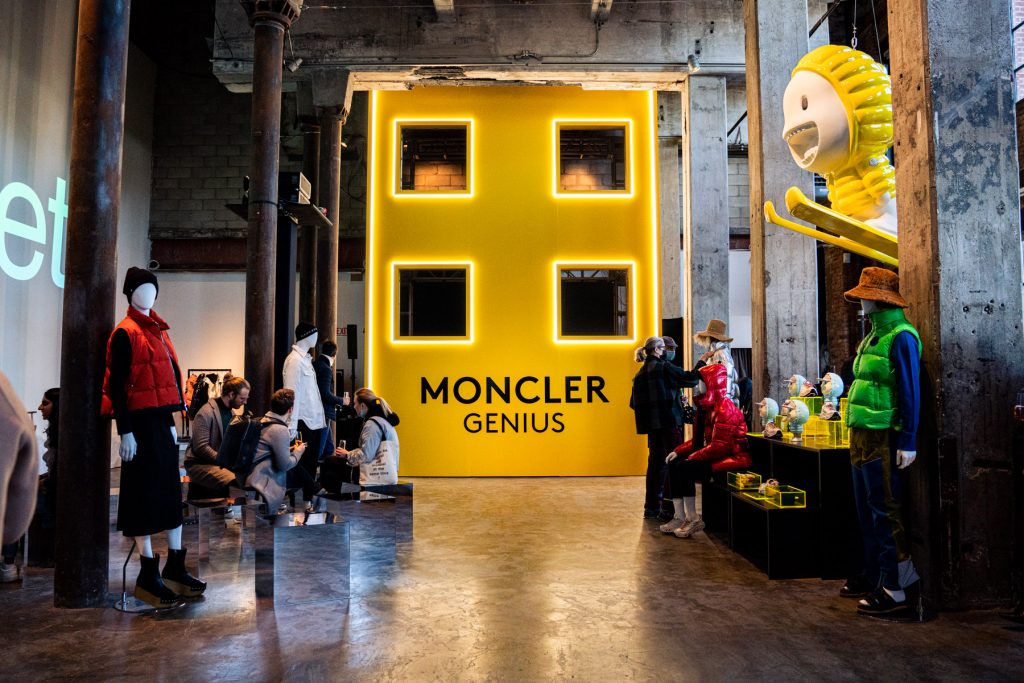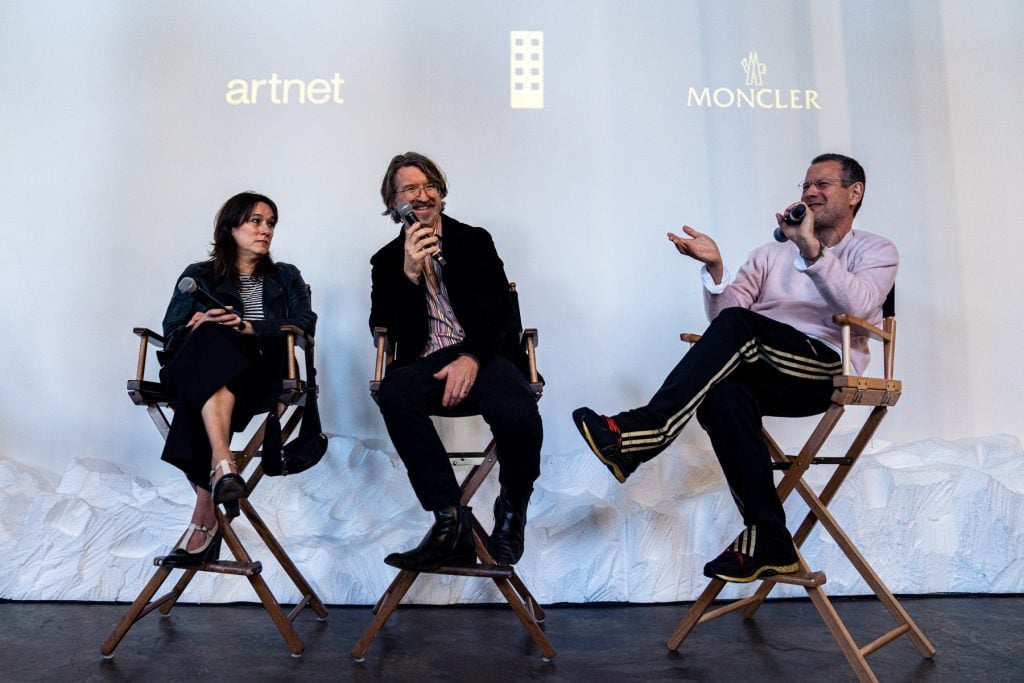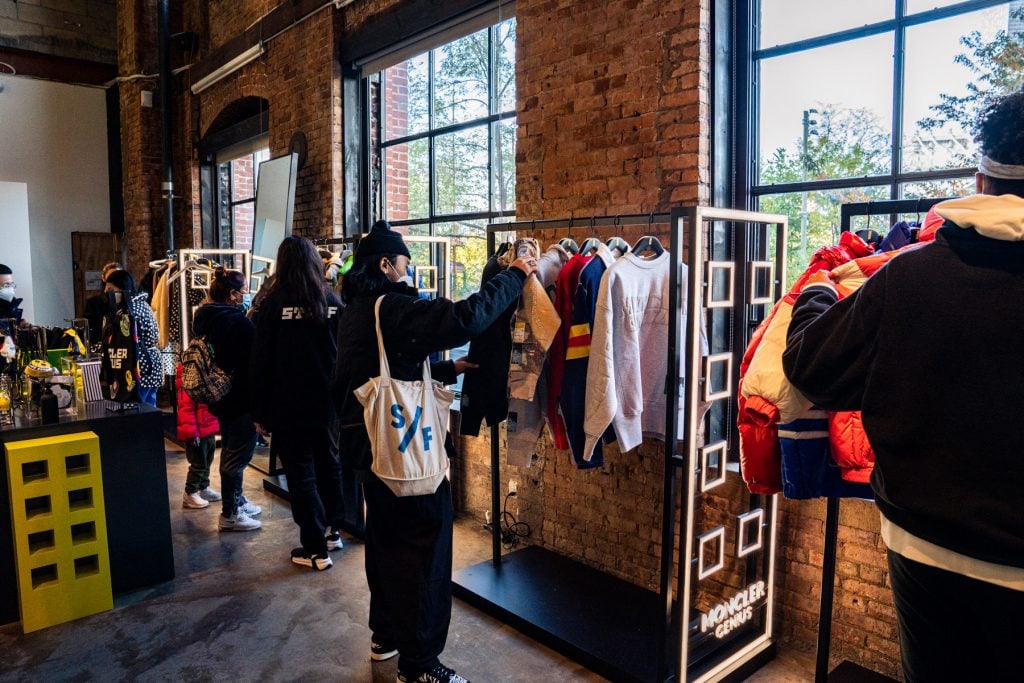Art & Tech
12 Things We Learned From the Artnet x Moncler Panel Discussion About the Warp-Speed Evolution of NFTs
The possibilities are endless, from collaborative beats with Timbaland to cutting art's carbon footprint.

The possibilities are endless, from collaborative beats with Timbaland to cutting art's carbon footprint.

Artnet News

Last week, as the sold-out NFT.NYC conference was taking place in midtown Manhattan, Artnet teamed up with fashion brand Moncler at their Brooklyn pop-up, House of Genius, to discuss the ins and outs of NFTs—what they are, how they’re changing the cultural world in fields from art to fashion to music, what they mean for artists, and more.
Moderated by Artnet News’s National Art Critic Ben Davis, the panel of guests included Artnet News Pro columnist Kenny Schachter and digital artists Jennifer and Kevin McCoy, the latter of who says he was the first artist to mint an NFT in 2014.
They engaged in a spirited discussion as fashion-and-art-loving attendees listened, asked questions about building out their own collections of digital artworks, and tried on pieces from Moncler’s collection.
We rounded up some of the most interesting quotes from the discussion below.

Photo courtesy Bryan Luna.
On what an NFT actually is…
“It’s a way to uniquely own a digital good, something that would otherwise be infinitely reproducible.” —Kevin McCoy
“I’d say it’s a digital certificate of authenticity, in a nutshell. In the 1970s, you’d buy a Dan Flavin and you’d get a fluorescent light fixture with a paper certificate. Because no one ever thought these things would be valuable, 80% of the people lost the certificate. Now you have the certificate lodged on the blockchain, but the art is a URL stored in the cloud somewhere.” —Kenny Schacter
On creating the “first” NFT…
“2013 was really kind of like the golden age of social media. People saw it as this kind of benevolent force. It was the height of open culture, open software, open source, Creative Commons, that kind of thing. And so digital artists were just, you know, ‘Give it away, give it away, give it away, send it out, send it out, send it out!’ So for me, when I saw that the Satoshi Bitcoin system was able to create something digital that was everywhere, yet still owned by somebody—still scarce, in a way, and merging those two things together, ubiquity and scarcity, in a digital environment—I was like, ‘That’s something that digital artists can use.’ If it’s possible to do it with money, it’s got to be possible to do it with digital art in some way. But I didn’t know how.
So in 2013 I spent many, many hours kind of thinking about this. Trying things out, reading, learning. It was a very, very small community back then…Then at the end of 2013 into 2014, the pieces came together for me, and I figured out a way that it could work. So initially I used the Namecoin blockchain and I created this series, went through this kind of choreographed series of steps, putting the work on the internet, and posting a link to it in a social media context to prove an ownership. I created a digital verification message that included a little contractual statement of ownership and bundle that turned the whole metadata construct into a blockchain transaction that could be sent to somebody…and that’s an NFT.” —Kevin McCoy
On how NFTs are democratizing the art market, not just for collectors but for artists, too…
“…And finally, thankfully, when I’m in my very, very late 50s, NFTs come along. So whereas Instagram was a way for people to express themselves, we still had to rely on this antiquated market system which is controlled by galleries, and galleries exert a lot of control over who gets to show art and who gets to buy art. And now with NFTs, there’s a 24/7 marketplace which is accessible to everybody.” —Kenny Schachter
On minting NFTs in the music industry…
“When we are working with musicians like Timbaland, we ask them to send us the stems, which are the broken-down tracks. And so instead of releasing the whole song, you just get to hear a beat. We have drums and bass and a couple of tracks of vocals, and so the idea is that collectors who download and buy the stems will be given a mixer to remix and use and maybe make their own NFTs in the future, from various hooks and beats that are coming from people like Timbaland. We’re working with Wu Tang Clan on another idea. It’s just a really interesting way to put music in the hands of the fans. And Timbaland was really interested in this idea of like, ‘How do I collaborate with my fans?’ This was one of the ways.” —Jennifer McCoy

Photo: Bryan Luna.
On how we’ve just scratched the surface of what NFTs can do…
“I feel like the [recent] monetizing of JPEGs was a great shot across the bow, like an entry level [to NFT production], especially for memes and things that have been in the culture that people wanted to see and own. But there’s so much utility to this technology in terms of plugging into software that can have content that can be delivered to you. [There are] all sorts of ideas about code-generated landscapes or environments that could happen. Or tickets to exclusive events that are then also collectibles…just a dizzying array of ideas that are coming across our computers.” —Jennifer McCoy
On why NFTs will stick around…
“The reason that NFTs are important, in my opinion, is what the real innovation is—which is [that] an NFT is how media becomes software. And by software I don’t mean, like, a digital object that’s operated on by software, like an image in your camera roll, but the actual software itself. The media becomes the software function, and that’s a totally new concept. And when that’s possible, it really unlocks a lot of things. And the excitement that we see this year around NFTs—I mean, the market hype is a big part of it, but it’s also a kind of marker of this [broader] enthusiasm, because it’s bigger than cryptocurrencies. It’s more important than cryptocurrencies themselves. And the success of NFTs, because of this media-becoming-software invention, means that regardless of the price of Bitcoin, the NFT concept is going to stay with us. And so that merger of software and media at this kind of intimate level is going to power a lot of changes that we’re going to see.” —Kevin McCoy
On why NFTs are more about art than crypto…
“If you want to make money in crypto, buy crypto, not art. Art is for people that care about art. The community in NFTs is like the word ‘important’ when you’re buying a piece of art. So the point is that there really is this shared sense of mutual interest, meeting really great people. None of us are cool; cool is not important. What’s important is just being able to further your interest. You have one life, and it’s really short. So you need to find a way to effectuate your passion. This is about love and passion and art, and that’s it as far as I’m concerned.” —Kenny Schachter
On why artists may benefit more from NFTs than traditional artwork…
“If I sign up to your new platform and I create an NFT, it will be embedded into that relationship and I will in perpetuity get a royalty.” —Kenny Schachter
On the technical limitations of NFTs…
“The only function an NFT can do besides mint is transfer. That’s what NFTs can do: mint and transfer, and delegate a transfer. And delegating a transfer is how you hand it over to the marketplace and the marketplace decides whether they honor the royalty or not.” —Kevin McCoy

Photo: Bryan Luna.
On why NFTs make art more “ownable” than ever…
“There’s a lot of conversations where people are promising that NFTs are going to do this or that. You don’t actually need an NFT-like digital token to do that. It’s kind of like generative art, for instance. But NFTs do make [art] ownable in a way that wasn’t before.” —Kevin McCoy
On NFTs and sustainability…
“[You don’t have] installs or storage issues. You know you’ve got your whole little wallet on your phone and maybe on a TV. If you want to transfer all of your art to another continent, it’s already there with you. So there are these things that are solved. And also, it’s a nascent industry in a time when carbon footprint is a huge idea and a huge problem. And I think that that will be an innovation around this for sure. If you’ve gone to an art fair, and the next day seen the mountain of debris [that results from all the packing materials], then you know to remove even 10% of that would be a great start.” —Jennifer McCoy
On the challenges of assessing the true cultural value of NFTs…
“What about middlemen, like music labels and galleries and curators?… I think you know we’re at the moment where there’s so much out there that all of a sudden the value of all these people [who curate comes to the fore]. Can we get rid of gatekeeping, but keep all of the education and discernment that a curator or a middleman would give you? That is, I think, a big question…how to find context. How does someone relate our project to another project and have a conversation about the differences between those two? Things like a panel will do it, but things like a museum show will do it—you know, very traditional things that NFTs and digital artists are really finding their way into…and that’s exciting to see. Maybe they’re not bridging everything, but having ideas and context really add to the value of what you’re looking at.” —Jennifer McCoy